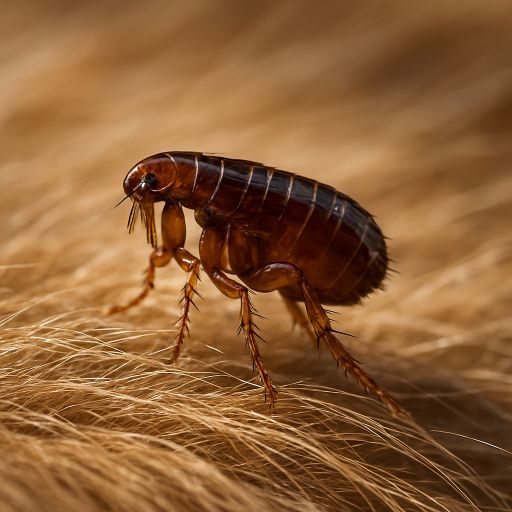
In recent years, Toronto pest control providers have reported a measurable uptick in flea-related service calls, particularly across residential high-density areas like North York’s Fairview Mall corridor, Etobicoke’s Humber College district, and Scarborough’s Morningside neighbourhood. While historically associated with rural and suburban pet-owning homes, flea infestations are now increasingly affecting urban condos, commercial shelters, and townhomes in the Greater Toronto Area (GTA).
DIY Flea Control in Toronto: What Homeowners Try, What Actually Works, and What Often Fails
While professional flea extermination services in Toronto remain the most reliable solution – especially in persistent or multi-room infestations – many residents initially attempt DIY methods before calling a licensed pest management professional (PMP). Some steps can help reduce flea pressure when properly applied, while others may delay effective treatment or exacerbate the issue.
🛠️ What Works (When Done Correctly)
| Method | Description | Notes |
|---|---|---|
| Vacuuming | Use a vacuum with HEPA filtration to remove flea eggs, larvae, pupae, and adults | Dispose of vacuum bag in sealed plastic outside the home immediately after use |
| High-Heat Washing | Wash pet bedding, rugs, throw blankets at 60°C or higher | Dry on the highest setting for at least 30 minutes to kill eggs and pupae |
| Pet Flea Treatments | Veterinary-prescribed topical or oral flea control for dogs and cats | Use only Health Canada-approved treatments (e.g., NexGard, Advantage II) |
| Food-Grade Diatomaceous Earth | Light dusting on carpet edges, pet paths, and baseboards | Use sparingly; avoid application where pets might inhale dust |
| Dehumidifiers | Reduces indoor humidity levels below 50% | Fleas require high humidity for larval development |
| Flea Combing | Daily combing using fine-toothed flea combs on pets | Collect and drown fleas in soapy water |
These tactics can form a basic control framework but rarely eliminate entrenched infestations without professional treatment. Flea pupae, which are highly resilient, often survive vacuuming and emerge days or weeks later – making follow-up critical.
⚠️ Common Mistakes That Delay Control
-
Misusing Over-the-Counter Foggers (“Bug Bombs”)
-
Often used in sealed apartments, these fail to penetrate carpets and harborage zones where fleas breed.
-
Foggers may cause insects to scatter or push deeper into inaccessible voids.
-
-
Skipping or Infrequent Vacuuming
-
One-time vacuuming is insufficient; daily effort is needed for weeks to disrupt the flea life cycle.
-
Pupae are protected by a cocoon and require multiple removal attempts.
-
-
Not Treating Pets Simultaneously
-
Fleas will reinfest the environment from untreated pets.
-
Pet owners should coordinate with a licensed veterinarian and PMP.
-
-
Using Flea Collars as a Primary Method
-
Many collars provide minimal protection or only repel rather than kill fleas.
-
Not effective as a standalone approach in active infestations.
-
-
Ignoring Outdoor Sources
-
Shaded, damp yards, under decks, and around pet rest areas may serve as flea breeding zones.
-
Wildlife like raccoons, squirrels, and stray cats may be vectors.
-
-
Failing to Schedule Follow-Up Checks
-
Even professional treatments require 2–3 service visits.
-
Homeowners often stop too early when adult fleas seem gone, unaware of pupae reemergence.
-
✅ When DIY Isn’t Enough
Toronto homeowners often attempt DIY flea control for 2–4 weeks before seeking help. If you’re seeing:
-
Fleas on socks after walking through carpeted areas
-
Pets persistently scratching despite treatment
-
Recurring bites on ankles or calves
…it’s time to involve a certified flea exterminator in Toronto who can execute an integrated pest management (IPM) strategy backed by residual insecticides, insect growth regulators (IGRs), and mechanical remediation tools like HEPA vacuums and desiccant dusts.
Treatment Protocols Used by Flea Exterminators in Toronto, written to align with the tone and standards of industry publications like PestWorld Canada and PMP Magazine:
Treatment Protocols Used by Flea Exterminators in Toronto
Effective flea extermination in Toronto depends on a multi-stage treatment strategy that targets both adult fleas and their immature life stages – eggs, larvae, and pupae. Given the resilience of pupae and the ability of fleas to remain dormant in protected zones for weeks, flea control professionals in the GTA must use layered interventions timed precisely with the insect’s reproductive cycle.
✅ Mechanical Control: The Non-Negotiables
Nearly every professional service begins with mechanical control methods designed to reduce the active population and eliminate harborage. These include:
-
HEPA-filter vacuuming of carpets, baseboards, and upholstered furniture – especially around pet sleeping areas
-
Washing bedding and linens at 60°C, which kills eggs and larvae
-
Disposal of vacuum contents in sealed plastic bags
-
Pet grooming and flea combing, often coordinated with a local veterinarian
These steps are critical before applying any chemical treatment. Skipping them can dramatically reduce efficacy and prolong the infestation.
✅ Chemical Control: Products and Modes of Action
Professional flea control in Toronto typically employs a combination of adulticides and insect growth regulators (IGRs). The most commonly used formulations in Ontario include:
| Product Type | Example | Mode of Action |
|---|---|---|
| IGR (Insect Growth Regulator) | Pyriproxyfen or Methoprene | Prevents larvae from pupating into adults |
| CS Formulation (Capsule Suspension) | Microencapsulated Permethrin | Controlled-release adulticide for longer residual effect |
| Desiccant Dusts | Silica gel, Diatomaceous earth | Abrades waxy cuticle, causing dehydration |
| Residual Insecticides | Synthetic pyrethroids (where permitted) | Fast knockdown, limited repellency |
In high-sensitivity zones – such as daycares, pet shelters, or condos with chemical restrictions – many Toronto exterminators now opt for biorational pesticides or botanical insecticides, which offer control with reduced environmental risk.
All product applications must comply with Health Canada’s PCP # requirements, and licensed applicators are required to follow REI (Restricted Entry Interval) guidelines.
✅ Integrated Pest Management (IPM) in Practice
The timing of treatments is crucial. Because pupal fleas are shielded from insecticides, many services in Toronto are delivered in two or three scheduled visits:
-
Initial treatment – Targeting adult fleas and larvae
-
Follow-up (7–14 days later) – Addressing fleas emerging from pupae
-
Final inspection (optional) – To verify elimination and close the service loop
A certified PMP will also conduct a site assessment, identify conducive conditions (e.g., clutter, pet hair accumulation, or rodent access points), and recommend long-term exclusion or sanitation measures.
For multi-unit buildings, some technicians now use zone isolation protocols and void treatments in shared mechanical rooms and hallways, especially where animal hosts like raccoons or squirrels may transit through rooflines or wall cavities.
✅ Customer Communication: What to Expect
Clear pre-treatment communication is integral to success. Most reputable companies in Toronto provide:
-
Client prep sheets (e.g., vacuuming checklist, pet treatment coordination)
-
Written service agreements outlining chemicals used and re-entry times
-
Post-treatment reports and guidance for continued monitoring
Without occupant compliance, especially in residential units, the chance of re-infestation from untreated hosts or premises remains high. Contact GTA Toronto Pest Control for a free quote.
Preparing for Flea Treatment in Toronto Homes: Checklists for Clients and Their Pets
For flea control treatments to be effective, especially in high-density urban environments like Toronto, client cooperation is essential. Whether servicing a detached home in High Park, a townhouse near Queen & Parliament, or a condo in Liberty Village, pest management professionals (PMPs) should provide a clear pre-treatment and post-treatment checklist. This ensures the treatment plan aligns with both entomological best practices and client expectations.
✅ Before Treatment: Homeowner & Pet Prep Guide
| Task | Why It Matters |
|---|---|
| Vacuum all carpeted floors, rugs, and furniture | Triggers emergence of dormant pupae and removes eggs, larvae |
| Wash pet bedding and blankets in hot water (60°C) | Flea eggs and larvae cannot survive high heat |
| Declutter floors, including under beds and sofas | Allows PMP access to baseboards, furniture legs, and pet resting areas |
| Cover aquariums and unplug air pumps | Protects aquatic life from airborne treatments |
| Inform PMP of pets, allergies, or sensitivities | Ensures chemical safety and product selection adheres to label restrictions |
| Vacuum upholstered car seats if pets are transported | Often overlooked reservoir of fleas and eggs |
| Secure or remove all pets (cats, dogs, birds, rodents, reptiles) | Required for both safety and effectiveness |
| Empty vacuum canister or bag outdoors immediately | Prevents reinfestation from captured fleas |
🚫 During Treatment: Access Restrictions and Timing
-
No people or animals should be inside the treatment zone during the application period.
-
Follow Restricted Entry Intervals (REI) as indicated by the product’s Health Canada PCP# label – typically 4 to 6 hours.
-
HVAC and ventilation may need to be adjusted depending on the formulation used (e.g., CS, SC, or desiccant dusts).
🐾 After Treatment: Post-Service Instructions for Flea Elimination Success
| Task | Why It’s Required |
|---|---|
| Do not mop or wash treated surfaces for at least 7–10 days | Allows residual insecticides to remain active across full flea emergence cycle |
| Resume daily vacuuming for 14 days | Stimulates adult emergence from pupae, making them susceptible to chemicals |
| Continue veterinary flea treatment for all pets | Prevents new infestation cycles from untreated hosts |
| Brush pets with flea combs daily | Removes remaining adults and allows for early detection of resurgence |
| Observe for signs of activity (flea dirt, pet scratching) | Track treatment effectiveness and schedule follow-up if needed |
| Re-book follow-up service if fleas persist after 21 days | Some infestations require 2–3 visits depending on infestation pressure |
🧾 Pro Tips from Toronto-Based PMPs
-
Leave behind a printed client prep sheet tailored to Toronto’s seasonal flea activity.
-
Offer guidance on laundering fabrics without shrinking items.
-
Recommend pet deworming for tapeworms post-infestation (communicated via veterinarian).
-
Emphasize environmental humidity as a factor – suggest portable dehumidifiers during summer peak.
🐕 Coordination with Pet Professionals
Integrated flea management often requires coordination between PMPs and veterinarians. Clients in Toronto’s east end (e.g., Beaches, Danforth) often rely on mobile vet clinics – working collaboratively helps ensure both the pet and home environments are synchronized for elimination.
Author Bio: Naeem Choudhry
Pest Control Expert
Naeem Choudhry is a seasoned pest control specialist with over 20 years of hands-on experience. Based in Toronto, he stays up to date with the latest industry best practices and is an active member of the National Pest Management Association of Canada.
Known for his practical tips and outstanding customer service, Naeem frequently hosts community workshops where he educates the public on pest identification, behaviour, and effective control methods. When he’s not out in the field, he shares his expertise through articles, educational events, and community outreach initiatives.
For more insights, follow him on x.com.
